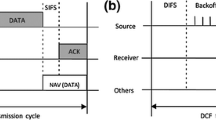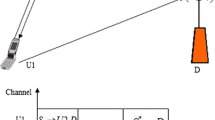Abstract
This article presents a low coordination overhead cooperative Automatic Repeat reQuest (ARQ) scheme with an integrated frame combiner, which exploits space diversity and cooperation between neighbouring nodes. A comparison between cooperation with and without frame combiner is also performed. In channels with a strong Line of Sight (LOS) component and low Signal-to-Noise ratio (SNR), the efficiency of the proposed protocol is many times higher than for other ARQ schemes. For non-LOS scenarios, the cooperative ARQ without frame combiner achieves the best efficiency results, and the overhead introduced by the frame combiner mechanism leads to results that can be even below the classical ARQ mechanism. In AWGN channels, the saturation throughput of the proposed scheme integrated into a IEEE 802.11 DCF based MAC is also studied. When the number of active stations is high, the cooperative ARQ without frame combiner shows to be the best option, while for light network loads, the presented scheme performs better.

















Similar content being viewed by others
Notes
This technique is called decode-and-forward in contrast with the amplify-and-forward technique used in [24].
Both C-ARQ and C-ARQ/FC when integrated with a CSMA/CA protocol.
References
Morillo-Pozo, J. D., & García-Vidal, J. (2007). A low coordination overhead C-ARQ protocol with frame combining. In PIMRC’07, 18th annual IEEE international symposium on personal, indoor and mobile radio communications. Athens, Greece.
Fitzek, F., & Katz, M. (2006). Cooperation in wireless networks: Principles and applications. Dordrecht, The Netherlands: Springer. ISBN-10: 1-4020- 4710-X, ISBN-13: 978-1-4020-4710-7.
Goldsmith, A. (2005). Wireless communications. Cambridge: Cambridge University Press. ISBN-10: 0521837163, ISBN-13: 9780521837163.
Miu, A., Balakrishnan, H., & Koksal, C. E. (2005). Improving loss resilience with multi-radio diversity in wireless networks. ACM Mobicom.
Tacca, M., Monti, P., & Fumagalli, A. (2005). Cooperative and non-cooperative ARQ protocols for microwave recharged sensor nodes. In Proceedings EWSN’05.
Zhao, B., & Valenti, M. C. (2005). Practical relay networks: A generalization of hybrid-ARQ. IEEE JSAC, 23(1), 7–18.
Morillo-Pozo, J., García-Vidal, J., & Pérez-Neira, A. (2005). Collaborative ARQ in wireless energy-constrained networks. In ACM-SIGMOBILE DIAL-M-POMC international workshop on foundation of mobile computing.
Eaves, R. E., & Levesque, A. H. (1977) . Probability of block error for very slow Rayleigh fading in Gaussian noise. In IEEE transactions on communications (pp. 368–374).
Bianchi, G. (2000). Performance analysis of the IEEE 802.11 distributed coordination function. IEEE Journal on Selected Areas in Communications, 18(3), 535–547.
Ni, Q., Li, T., Turletti, T., & Xiao, Y. (2005). Saturation throughput analysis of error-prone 802.11 wireless networks. Wiley Journal of Wireless Communications and Mobile Computing (JWCMC), 5(8), 945–956.
Rodrig, M., Reis, C., Mahajan, R., Wetherall, D., & Zahorjan, J. (2005). Measurement-based characterization of 802.11 in a hotspot setting. In SIGCOMM’05 workshops. Philadelphia, PA.
Dianati, M., Ling, X., Naik, S., & Shen, X. (2006). A node cooperative ARQ scheme for wireless ad-hoc networks. IEEE Transactions on Vehicular Technology, 55(3), 1032–1044.
Alonso-Zárate, J., Kartsakli, E., Verikoukis, Ch., & Alonso, L. (2008). Persistent RCSMA: A MAC protocol for a distributed cooperative ARQ scheme in wireless networks. EURASIP Journal on Advanced Signal Processing, Special Issue on Wireless Cooperative Networks, 2008, 13, article ID 817401.
Morillo-Pozo, J., Trullols, O., Barceló, J. M., & García-Vidal, J. (2008). A cooperative ARQ for delay-tolerant vehicular networks. In IEEE international workshop on delay-tolerant mobile networks (DTMN’08), in conjunction with ICDCS 2008. Beijing, China.
Bicket, J., Aguayo, D., Biswas, S., & Morris, R. (2005). Architecture and evaluation of an unplanned 802.11b mesh network. In MobiCom’05. Cologne, Germany.
Pérez-Romero, J., Agustí, R., & Sallent, O. (2003). Analysis of a type II hybrid ARQ strategy in a DS-CDMA packet transmission environment. IEEE Transactions on Communications, 51(8), 1249–1253.
Xu, W., Lin, J., Niu, K., & Wu, L. (2009). Performance analysis of cooperative ARQ with code combining over Nakafami-m fading channels. In Wireless Personal Communications. doi:10.1007/s11277-009-9740-1.
Laneman, J. N., Tse, D. N. C., & Wornell, G. W. (2004). Cooperative diversity in wireless networks: Efficient protocols and outage behaviour. IEEE Transactions on Information Theory, 50(12), 3062–3080.
Le, L., & Hossain, E. (2008). An analytical model for ARQ cooperative diversity in multihop wireless networks. IEEE Transactions on Wireless Communications, 7(5), 1786–1791.
Yu, G., Zhang, Z., & Qiu, P. (2006). Cooperative ARQ in wireless networks: Protocols description and performance analysis. IEEE International Conference on Communications, 8, 3608–3614.
Zhang, C., Wang, W., & Wei, G. (2009). Design of ARQ protocols for two-user cooperative diversity systems in wireless networks. Elsevier Journal of Computer Communications, 32, 1111–1117.
Ochiai, H., Mitran, P., & Tarokh, V. (2006). Variable-rate two-phase collaborative communication protocols for wireless networks. IEEE Transaction on Information Theory, 52(9), 4299–4313.
Mahinthan, V., Rutagemwa, H., Mark, J. W., & Shen (Sherman), X. (2009). Cross-layer performance study of cooperative diversity system with ARQ. IEEE Transactions on Vehicular Technology, 58(2), 705–719.
Choi, W., Kim, D. I., & Kim, B.-H. (2010). Adaptive multi-node incremental relaying for hybrid-ARQ in AF relay networks. IEEE Transactions on Wireless Communication, 9(2), 505–511.
Xiong, L., Libman, L., & Mao, G. (2008). Optimal strategies for cooperative MAC-layer retransmission in wireless networks. In Proceedings of IEEE WCNC.
Yu, G., Zhang, Z., & Qiu, P. (2007). Efficient ARQ protocols for exploiting cooperative relaying in wireless sensor networks. Computer Communications, 30(14–15), 2765–2773.
Stanojev, I., Simeone, O., Bar-Ness, Y., & Kim, D. H. (2009). Energy efficiency of non-collaborative and collaborative hybrid-ARQ protocols. IEEE Transactions on Wireless Communications, 8(1), 326–335.
Dai, L., & Letaief, K. B. (2008). Throughput maximization of ad-hoc wireless networks using adaptive cooperative diversity and truncated ARQ. IEEE Transactions on Communications, 56(11), 1907–1918.
Cerutti, I., Fumagalli, A., & Gupta, P. (2008). Delay models of single-source single-relay cooperative ARQ protocols in slotted radio networks with Poisson frame arrivals. IEEE/ACM Transactions on Networking, 16, 371–382.
Acknowledgments
This work has been supported by the Spanish Ministery of Science and Technology under grant TIN2010-21378-C02-01 and by the EuroFGI Network of Excellence of the VI FP of the EU. The authors wish to thanks the reviewers for their detailed comments and suggestions.
Author information
Authors and Affiliations
Corresponding author
Appendices
Appendix A
In this appendix we derive the expression for \( Q_{CARQ/FC} \) for the case M = 3. Let n 1, n 2 and n 3 be the number of errors on each of the 3 erroneously received frames in an AWGN channel (with n i > 0 for i = 1…3). The probability that the MV succeeds would be the same as the probability that there are not two errors in the same position. To obtain an expression for this probability, we can use a simple balls and bins model: We have L bins (the positions in the frame) in which we have to put first n 1 balls (one in each bin), then n 2 and finally n 3 . We will calculate the wanted probability as favourable cases/possible cases. Note that in the favourable configurations, for the n 2 balls there are n 1 forbidden bins, while for the n 3 balls the number of forbidden bins is n 1 + n 2 , thus leading to:
Defining L n = L(L − 1)…(L − n + 1), we obtain:
We use this expression to calculate P(MV correct frame | CARQ incorrect frame) (i.e. the probability of a correct reconstruction for all possible values of n 1, n 2 and n 3 with n i > 0 for i = 1…3, and taking into account the BER of the channel):
The final expression for \( Q_{CARQ/FC} \)for the case M = 3 is:
Appendix B
We compare in next figures Eqs. ( 5 ) and ( 6 ) for the three studied channels and M = 3 to show that the differences introduced by our approximation are minimal. We represent the y axis in bits instead of time to make the results independent of the actual bit rate of the used technology. For all the plots we are considering frames of 10,240 bits and signalling messages of 240 bits (Figs. 18, 19 and 20).
Appendix C
-
1.
The time for the Idle slot will be (where σ is the PHY layer actual time slot):
$$ T_{I} = \sigma $$ -
2.
The time for the direct Success slot would be: T S = 2T PHYhdr + T data + 2δ + T SIFS + T ack + T DIFS , where δ is the propagation delay, but for simplicity we will ignore it so the final expression for T S will be (we will skip this step on the rest of time slots):
$$ T_{S} = 2T_{PHYhdr} + T_{data} + T_{SIFS} + T_{ack} + T_{DIFS} $$ -
3.
The time for the C-ARQ Success slot (i.e. some cooperator has the correct frame) will be:
$$ \begin{aligned} T_{CARQ} & = 2 \cdot (T_{PHYhdr} + T_{data} + T_{SIFS} ) + \left( {\frac{M}{2} - 1} \right) \cdot (T_{PHYhdr} + T_{diff}^{(2)} + T_{SIFS} ) \\ & + T_{PHYhdr} + T_{diff}^{(1)} + T_{SIFS} + T_{PHYhdr} + T_{ack} + T_{DIFS} \\ \end{aligned} $$ -
4.
The time for the FC Success slot (i.e. any cooperator has the correct copy but the frame combiner success in the reconstruction) will be:
$$ \begin{aligned} T_{FC} & = 2 \cdot (T_{PHYhdr} + T_{data} + T_{SIFS} ) \\ & + (M - 1)\left( {T_{PHYhdr} + T_{diff}^{(2)} + T_{SIFS} } \right) \\ & + T_{PHYhdr} + T_{ack} + T_{DIFS} \\ \end{aligned} $$In the previous expression we can distinguish three parts:
-
Original transmission + transmission from the destination to its cooperators:
$$ 2 \cdot (T_{PHYhdr} + T_{data} + T_{SIFS} ) $$-
Transmission of the differences from the cooperators:
$$ (M - 1)\left( {T_{PHYhdr} + T_{diff}^{(2)} + T_{SIFS} } \right) $$-
ACK:
$$ T_{PHYhdr} + T_{ack} + T_{DIFS} $$ -
-
5.
Two different times for a Collision slot could be considered. If nodes were able to distinguish between collisions and transmission errors, they would abort the recovering process (i.e. cooperation) when a collision occurs and the time would be:
$$ T_{C} = T{}_{PHYhdr} + T_{data} + T_{EIFS} $$Note that using this time for T c when calculating the saturation throughput of the system gives a best-case figure so it would represent an upper bound for the real value. On the contrary, we will assume that the receiver always tries to recover the frame. Note however that we cannot calculate the probability of recovering the frame because the BER does not depend only on the SNR of the channel but also on the errors induced by the collision. So we will assume that the recovering process will always fail, giving to us a worst-case figure for the saturation throughput. Taking into account all these considerations, we will use:
$$ T_{C} = T_{E}^{data} $$ -
6.
The time for a Data Error slot (i.e. everything fails and a retransmission from the original sender is needed) will be:
$$ T_{E}^{data} = 2(T_{PHYhdr} + T_{data} + T_{SIFS} ) + (M - 1)\left( {T_{PHYhdr} + T_{diff}^{(2)} + T_{SIFS} } \right) + T_{EIFS} $$
Note that this time slot is equal to the T FC but changing the last part corresponding to the transmission of the ACK (\( T_{PHYhdr} + T_{ack} + T_{DIFS} \)) by T EIFS .
These are the 6 different time slots that we consider (recall that we assume that the ACK is always received correctly, and consequently there is not a time slot for the situation in which the ACK transmission fails).
Rights and permissions
About this article
Cite this article
Morillo, J., García-Vidal, J. A cooperative-ARQ protocol with frame combining. Wireless Netw 17, 937–953 (2011). https://doi.org/10.1007/s11276-011-0326-y
Published:
Issue Date:
DOI: https://doi.org/10.1007/s11276-011-0326-y







